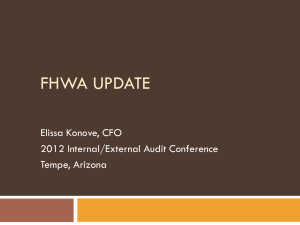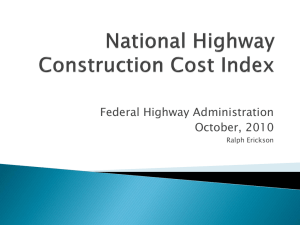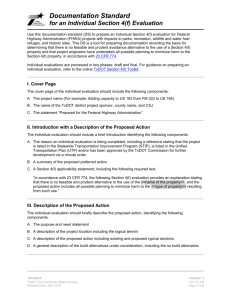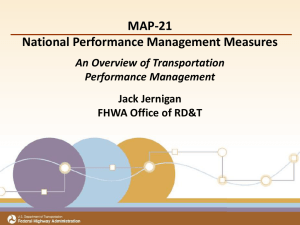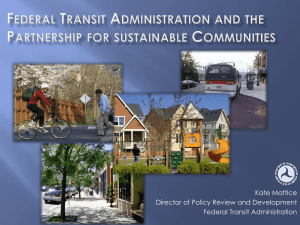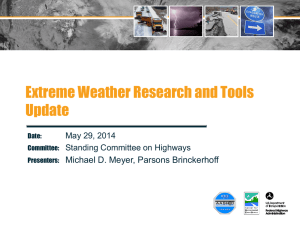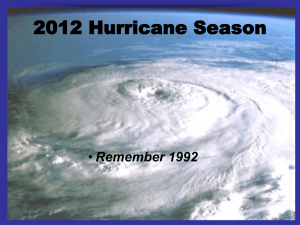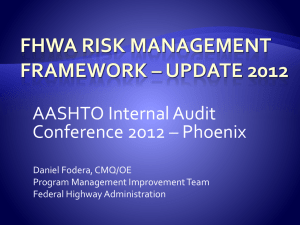Section 4(f) Evaluation Template
advertisement
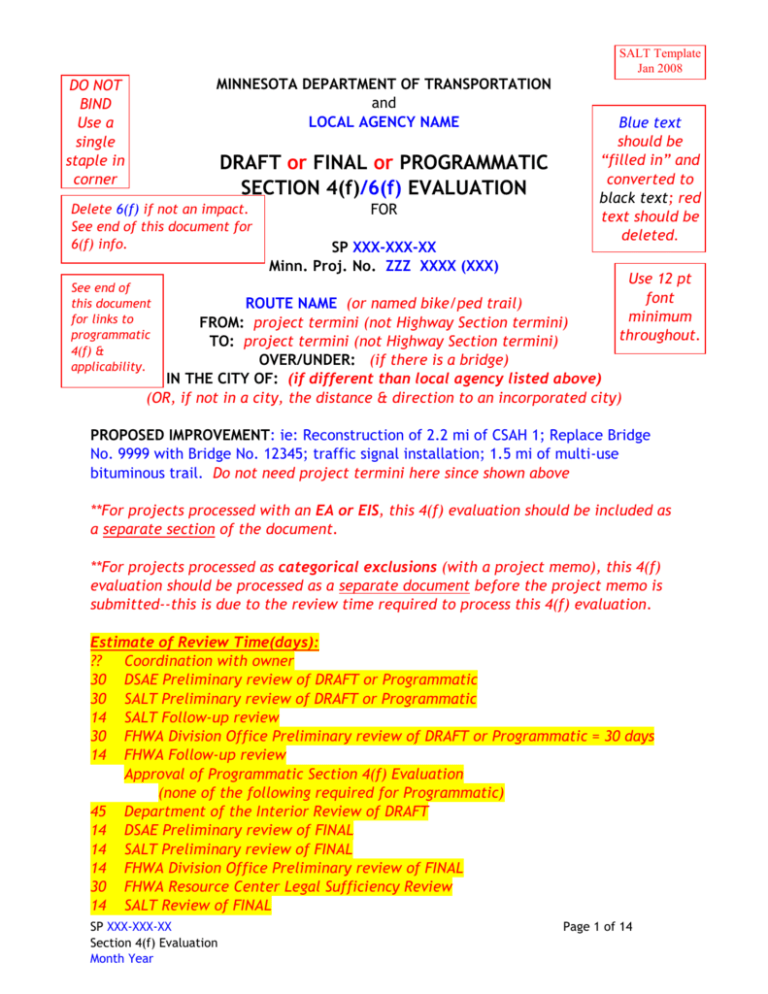
SALT Template Jan 2008 MINNESOTA DEPARTMENT OF TRANSPORTATION and LOCAL AGENCY NAME DO NOT BIND Use a single staple in corner DRAFT or FINAL or PROGRAMMATIC SECTION 4(f)/6(f) EVALUATION Delete 6(f) if not an impact. See end of this document for 6(f) info. See end of this document for links to programmatic 4(f) & applicability. FOR SP XXX-XXX-XX Minn. Proj. No. ZZZ XXXX (XXX) Blue text should be “filled in” and converted to black text; red text should be deleted. Use 12 pt font minimum throughout. ROUTE NAME (or named bike/ped trail) FROM: project termini (not Highway Section termini) TO: project termini (not Highway Section termini) OVER/UNDER: (if there is a bridge) IN THE CITY OF: (if different than local agency listed above) (OR, if not in a city, the distance & direction to an incorporated city) PROPOSED IMPROVEMENT: ie: Reconstruction of 2.2 mi of CSAH 1; Replace Bridge No. 9999 with Bridge No. 12345; traffic signal installation; 1.5 mi of multi-use bituminous trail. Do not need project termini here since shown above **For projects processed with an EA or EIS, this 4(f) evaluation should be included as a separate section of the document. **For projects processed as categorical exclusions (with a project memo), this 4(f) evaluation should be processed as a separate document before the project memo is submitted--this is due to the review time required to process this 4(f) evaluation. Estimate of Review Time(days): ?? Coordination with owner 30 DSAE Preliminary review of DRAFT or Programmatic 30 SALT Preliminary review of DRAFT or Programmatic 14 SALT Follow-up review 30 FHWA Division Office Preliminary review of DRAFT or Programmatic = 30 days 14 FHWA Follow-up review Approval of Programmatic Section 4(f) Evaluation (none of the following required for Programmatic) 45 Department of the Interior Review of DRAFT 14 DSAE Preliminary review of FINAL 14 SALT Preliminary review of FINAL 14 FHWA Division Office Preliminary review of FINAL 30 FHWA Resource Center Legal Sufficiency Review 14 SALT Review of FINAL SP XXX-XXX-XX Section 4(f) Evaluation Month Year Page 1 of 14 14 FHWA Division Office Review of FINAL State Map to follow Title Page Purpose: Where is the project relative to the State SP xxx-xxx-xxx STATE MAP SP XXX-XXX-XX Section 4(f) Evaluation Month Year Page 2 of 14 Location Map to follow State Map Identify the entire highway section. Identify the begin & end of the project. Include project number. Include old & new bridge numbers. Show at least one incorporated city. Show township & range. Label all roads & facilities referred to in the document. Show parks, public wildlife refuges, public golf courses, wild & scenic rivers & historic properties, etc. Show railroads. If trail project, show trail system. Graphics clear and readable SP XXX-XXX-XX Section 4(f) Evaluation Month Year Page 3 of 14 I. REPORT PURPOSE The purpose of this Section 4(f) Evaluation is to document information needed by the FHWA to make a decision regarding the use of a property protected by Section 4(f) legislation (49 USC 303 & 23 USC 138) and 6(f) legislation (16 USC Sec. 2509), and FHWA Section 4(f) regulations under 23 CFR 771.135(a). Delete 6(f) if not applicable II. PROPOSED ACTION A. PROPOSED PROJECT A brief description of what is being proposed to be built. Route: Termini--From: To: Length: General description of section and type of work: ie: The proposed project will reconstruct this 2 lane urban roadway, including parking lanes, sidewalks, curb & gutter, street lighting, and a traffic signal at _____ Street. OR… ie: This project consists of reconstruction of this 2 lane rural roadway to a 4 lane urban roadway, with curb & gutter, storm sewer, sidewalks, left & right turn lanes, and replacement of utilities. Bridge 0000 over the ____ River will be replaced with Bridge 99999 OR…other B. PROJECT PURPOSE & NEED Deficiencies of the existing facility: ie: inadequate lane and/or shoulder widths, load restrictions, safety deficiencies, ped/bike safety, access spacing, traffic congestion. If possible, deficiencies must be quantified. If a bikeway is included, discuss existing and/or proposed state/regional/local bikeway system. Bridge Sufficiency Rating: ____ Structure Inventory attached Check rating against official FHWA list. Structurally Deficient: Yes/No Functionally Obsolete: Yes/No Project Objectives Why these deficiencies need to be corrected at this time? --what’s wrong? The following list is representative, not all inclusive: --to provide a level of service that is consistent with the transportation needs of area residents, businesses/industries and farms SP XXX-XXX-XX Section 4(f) Evaluation Month Year Page 4 of 14 --to improve public safety by providing a roadway that conforms to the current minimum standards for geometry and width --to insure the continued serviceability of the route III. DESCRIPTION OF THE SECTION 4(f) PROPERTY A. NAME: B. SIZE: C. LOCATION: D. OWNERSHIP: City, County, State, Federal, etc. E. TYPE OF SECTION 4(F) PROPERTY: park, recreation, historic, etc. F. FUNCTION OF OR AVAILABLE ACTIVITIES ON THE PROPERTY: ball playing, swimming, golfing, etc. G. DESCRIPTION AND LOCATION OF ALL EXISTING AND PLANNED FACILITIES: ball diamonds, tennis courts, picnic shelter, etc H. ACCESS: location, pedestrian, vehicular I. USAGE: approximate number of users/visitors, etc. J. RELATIONSHIP TO OTHER SIMILARLY USED LANDS IN THE VICINITY: name, location, facilities provided K. APPLICABLE CLAUSES AFFECTING THE OWNERSHIP: lease, easement, covenants, restrictions, or conditions, including forfeiture L. UNUSUAL CHARACTERISTICS OF THE SECTION 4(F) PROPERTY THAT EITHER REDUCE OR ENHANCE THE VALUE OF ALL OR PART OF THE PROPERTY: flooding problems, terrain conditions, or other features M. 6(F) IMPACTS: If using land from a site purchased or improved with funds under the Land and Water Conservation Fund Act (LAWCON), the Federal Aid in Fish Restoration Act (Dingell-Johnson Act), the Federal Aid in Wildlife Act (Pittman-Robertson Act), or the land is otherwise encumbered with a Federal interest (e.g., former Federal surplus property. N. ATTACHED: --Detailed map or drawing of sufficient scale to identify the relationship of each alternative to the Section 4(f) property --Other exhibits such as photographs, sketches, etc. SP XXX-XXX-XX Section 4(f) Evaluation Month Year Page 5 of 14 IV. IMPACTS TO THE SECTION 4(f) PROPERTY The following alternatives have impacts to the 4(f) property name. If more than one resource is being evaluated in this document, use a table for each. ALTERNATIVES (1) Impacts to the Preferred Build Other Other 4(f) Property Alternative Alternative (2) Alternative (2) Amount of land to be used, ac or SF Facilities affected Functions affected Access Unique problems Unusual factors Visual intrusion Other: Other 4(f)/6(f) property Air Quality Endangered Species Floodplain Hazardous Materials Historic Noise Relocations Water Quality Wetlands Other… Project Cost Additional information on items above: (1) Impacts that can be quantified, should be quantified, and those that cannot be quantified should be briefly described. If this document is SP XXX-XXX-XX Section 4(f) Evaluation Month Year Page 6 of 14 attached to an EA or EIS, detailed discussions of alternatives in the EA or EIS may be referenced & briefly summarized in this table. (2) Location alternatives, design alternates, ie: rehab vs. replace. V. AVOIDANCE ALTERNATIVES The following alternatives avoid the use of the 4(f) property name. If more than one resource is being evaluated in this document, use a table for each. AVOIDANCE ALTERNATIVES (1) Do Nothing Other Other Impacts Alternative Alternative (2) Alternative (2) Other 4(f)/6(f) Properties Air Quality Controversy Endangered Species Environmental Justice Farmland Floodplain Hazardous Materials Historic Noise Relocations Right-of-Way Section 404 Water Quality Wetlands Other… Safety Issues Design Issues ie: bridge length Traffic Issues Maintenance Issues Project Cost Additional Information on items above: (1) Impacts that can be quantified, should be quantified, and those that SP XXX-XXX-XX Section 4(f) Evaluation Month Year Page 7 of 14 cannot be quantified should be described. If this document is attached to an EA or EIS, detailed discussions of alternatives may be referenced & briefly summarized in this table. (2) Location alternatives, design alternates (design alternates should be in the immediate area of the property and consider items such as minor alignment shifts, a reduced facility, retaining structures, rehab vs. replace, etc. either individually or in combination, as appropriate). Other “avoidance” alternatives eliminated from detailed study, if any: Describe & explain why these alternatives are not feasible & prudent. VI. MEASURES TO MINIMIZE HARM Discuss all possible measures which are available to minimize impacts to the 4(f) property; detailed discussions of mitigation measures in the EA or EIS may be referenced & briefly summarized, rather than repeated. The proposed action includes all possible planning to minimize harm. Proposed mitigation measures include the following: The following list is representative, not all inclusive. --Replacement of lands used with lands of reasonably equivalent usefulness and location and of at least comparable value --Replacement of facilities impacted by the project including sidewalks, paths, benches, lights, trees, and other facilities --Restoration and landscaping of disturbed areas --Incorporation of design features, ie: reduction in right-of-way width, modifications to the roadway section, retaining walls, curb and gutter sections, and minor alignment shifts --Incorporation of habitat features, ie: construction of new, or enhancement of existing, wetlands or other special habitat types --Payment of the fair market value of the land and improvements taken --Improvements to the remaining Section 4(f) site equal to the fair market value of the land and improvements taken For historic sites, measures to minimize harm will consist of those measures necessary to preserve the historic integrity of the site and agreed to by Mn/DOT Cultural Resources, SHPO and the FHWA. VII. COORDINATION Coordination with the Federal, State, or Local public official having jurisdiction over the Section 4(f) property, or the property owner of a privately SP XXX-XXX-XX Section 4(f) Evaluation Month Year Page 8 of 14 owned historic site: Address “significance” if it is an issue. Coordination with Mn/DOT Cultural Resources Unit, SHPO/THPO, and ACHP, if appropriate: 6(f) Property: --Coordination with the DNR contact, Joe Hiller: --Coordination with the DOI/National Park Service (through the DNR): Correspondence attached: The following list is representative, not all inclusive. --Letter from property owner --Mn/DOT Cultural Resources Determination --SHPO Concurrence --DOI preliminary approval PROCCESSING OF THE DRAFT SECTION 4(F) EVALUATION (does not apply to “Programmatic” Section 4(f) Evaluations): 16 15 14 12 VIII. copies copies copies copies Local Agency to the DSAE--see 1st page for estimated review times. DSAE to SALT SALT to the FHWA FHWA to the DOI for a 45 day review. CONCLUSION This section is left out of the DRAFT Section 4(f) Evaluation, but is included in the FINAL Section 4(f) Evaluation, and a Programmatic Section 4(f) Evaluation. A. BASIS FOR CONCLUDING THAT THERE ARE NO FEASIBLE AND PRUDENT ALTERNATIVES TO THE USE OF THE SECTION 4(f) PROPERTY. The supporting information in section 4 above demonstrates that there are unique problems or unusual factors involved in the use of alternatives that avoid this Section 4(f) Property or that the cost, social, economic, and environmental impacts, or community disruption resulting from such alternatives reach extraordinary magnitudes (see definition at the end), as summarized below: The following lists are representative, not all inclusive: 1. The “do nothing” alternative is not feasible and prudent because: SP XXX-XXX-XX Section 4(f) Evaluation Month Year Page 9 of 14 a. it would not correct existing or projected capacity deficiencies, OR b. it would not correct existing safety hazards, OR c. it would not correct existing deteriorated conditions and maintenance problems, AND d. not providing such correction would constitute a cost or community impact of extraordinary magnitude, or would result in unique problems or unusual factors, when compared with the proposed use of the Section 4(f) lands. e. other 2. It is not feasible and prudent to avoid Section 4(f) lands by minor alignment shifts or design alternatives, because implementing such measures would result in: a. substantial adverse community impacts to adjacent homes, businesses or other improved properties, OR b. substantially increased roadway or structure cost, OR c. unique engineering, traffic, maintenance, or safety problems, OR d. substantial adverse social, economic, or environmental impacts, OR e. the project not meeting identified transportation needs, AND f. impacts, costs, or problems that would be truly unusual or unique, or of extraordinary magnitude when compared to the use of the Section 4(f) property. g. other 3. It is not feasible and prudent to avoid Section 4(f) lands by constructing on new alignment, because: a. the new location would not solve existing transportation, safety, or maintenance problems, OR b. the new location would result in substantial adverse social, economic, or environmental impacts, ie: extensive severing of productive farmlands, displacement of a substantial number of families or businesses, serious disruption of established patterns, substantial damage to wetlands or other sensitive natural areas, or greater impacts to other Section 4(f) lands, OR c. the new location would substantially increase costs or engineering difficulties, ie: an inability to achieve minimum design standards, inability to meet the requirements of various permitting agencies such as those involved with navigation, pollution, and the environment, AND d. such impacts, costs, or problems would be truly unusual or unique, or of extraordinary magnitude when compared with the proposed use of Section 4(f) lands. e. other B. BASIS FOR CONCLUDING THAT THE PROPOSED ACTION INCLUDES ALL POSSIBLE PLANNING TO MINIMIZE HARM TO THE SECTION 4(f) PROPERTY SP XXX-XXX-XX Section 4(f) Evaluation Month Year Page 10 of 14 The preferred alternative has the least harm on the Section 4(f) property after considering mitigation to the Section 4(f) property. Mitigation measures include the following: --design modifications --landscaping The officials having jurisdiction over the Section 4(f) property have agreed, in writing, with the assessment of impacts resulting from the use of the Section 4(f) property and with the mitigation measures to be provided. C. SUMMARY OF THE FORMAL COORDINATION (Not for Programmatic) Include copies of all formal coordination comments and a summary of other relevant Section 4(f) comments received and analysis and response to any questions raised. Summary of comments received: Attach correspondence Response to questions raised: Attach correspondence New alternatives or modifications to existing alternatives that will not be given further consideration; basis for dismissing these alternatives: Support by factual information. If 6(f) property: Coordination with the DOI since the Draft Section 4(f) Evaluation: Attach correspondence D. CONCLUDING STATEMENT Based upon the above considerations, there is no feasible and prudent alternative to the use of land from the Section 4(f) property, and the proposed action includes all possible planning to minimize harm to the Section 4(f) property resulting from such use." SP XXX-XXX-XX Section 4(f) Evaluation Month Year Page 11 of 14 PROCCESSING OF THE FINAL SECTION 4(f) EVALUATION: 6 copies Local Agency to the DSAE 5 copies DSAE to SALT 4 copies SALT to the FHWA 2 copies FHWA to the FHWA Resource Center for a 30 day Legal Sufficiency Review PROCCESSING OF A PROGRAMMATIC SECTION 4(f) EVALUATION: 4 copies Local Agency to the DSAE 3 copies DSAE to SALT 2 copies SALT to the FHWA LINKS TO 4(f) INFORMATION: http://www.environment.fhwa.dot.gov/projdev/4fregs.asp http://www.environment.fhwa.dot.gov/projdev/4fpolicy.asp http://www.environment.fhwa.dot.gov/projdev/4feval.asp http://www.kci.com/projects/4f/pdf_files/ta66408a.htm#4f LINKS TO PROGRAMMATIC SECTION 4(f) EVALUATIONS: http://www.environment.fhwa.dot.gov/projdev/4fmparks.asp http://www.environment.fhwa.dot.gov/projdev/4fmhist.asp http://www.environment.fhwa.dot.gov/projdev/4fbridge.asp http://www.environment.fhwa.dot.gov/projdev/4fbikeways.asp http://www.environment.fhwa.dot.gov/projdev/4fnetbenefits.asp SECTION 6(f) INFO: In development… SP XXX-XXX-XX Section 4(f) Evaluation Month Year Page 12 of 14 DEFINITIONS: Significance (for Section 4(f) purposes) Significance means that in comparing the availability and function of the recreation, park, or wildlife and waterfowl refuge area with the recreational, park, and refuge objectives of that community, the land in question plays an important role in meeting those objectives. A historic site is considered significant if it is on or eligible for the National Register of Historic Places. Extraordinary Magnitude A reference to exceedingly high costs or other objectionable factors associated with a project alternative, extraordinary magnitude characterizes the impacts to Section 4(f) or non-Section 4(f) resources as beyond the boundaries of feasible and prudent Feasible and Prudent A term that is integral to the Section 4(f) process, feasible and prudent refers to the viability of an alternative that avoids the use of a Section 4(f) resource. The term "feasible" refers to the constructibility of a project — whether or not it can be built using current construction methods technologies and practices. The term "prudent" refers to how reasonable the alternative is — in essence, whether or not it makes sense. Given a range of options, a transportation agency must select an avoidance alternative if it is feasible and prudent. By contrast, an alternative may be rejected if it is not feasible and prudent. An alternative may be considered not feasible and prudent for any of the following reasons: does not meet project purpose and need excessive cost of construction severe operational or safety problems unacceptable social, economic or environmental impacts serious community disruption a combination of any of the above MISCELLANEOUS ISSUES: Exhibits/attachments: should be easily reproducible, ie: 8 ½ x 11, black and white Preparation in dual units is no longer required, but the units in this document should match t hose in the plan. SP XXX-XXX-XX Section 4(f) Evaluation Month Year Page 13 of 14 Do not include dividers for each attachment. Consistently use either single-sided or double-sided pages—some attachments are lost when just double siding a few attachments. Do not use tabs for attachments—slow down reproduction and don’t fit well in envelopes. Do not attach whole studies—instead, in the body of the PM, summarize the results of the studies & state where the study is available. Do not reference stationing—is hard to relate to without a plan sheet with stationing shown—use distances to a known point or facility shown on the location map. SP XXX-XXX-XX Section 4(f) Evaluation Month Year Page 14 of 14
